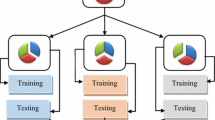Abstract
This study explores the use of the nonlinear principal component analysis (NLPCA) technique for detecting gas turbine faults. The resurgence of interest in neural network-based NLPCA in recent years has propelled its application in fault diagnosis. In this context, a five-layer neural network NLPCA approach is employed to model normal gas turbine operation without faults. The fault detection relies on the filtered squared prediction error index. The research involves determining the optimal count of retained principal components within the PCA model and validating this model by comparing actual and estimated variables. The efficacy and dependability of this approach in gas turbine defect detection are demonstrated, contrasting it with the linear principal component analysis approach. Real gas turbine operational data spanning four years is utilized for this comparison. The findings underscore the superior efficiency of the chosen NLPCA approach, suggesting its value as a robust tool for fault monitoring and diagnosis in gas turbines.










Similar content being viewed by others
References
S. Ashish, E. Dale, Evaluation of pattern matching method for the Tennessee Eastman challenge process. J. Process. Control. 16, 601–613 (2006)
Y. Uchida, K. Fujiwara, T. Saito, T. Osaka, Process fault diagnosis method based on MSPC and LiNGAM and its application to tennessee eastman proces. IFAC-PapersOnLine. 55(2), 384–389 (2022). https://doi.org/10.1016/j.ifacol.2022.04.224
T. Hastie, W. Stuetzle, Principal curves. J. Am. Statist. Assoc. 84(406), 502–516 (1989)
A.K. Pani, Non-linear process monitoring using kernel principal component analysis, a review of the basic and modified techniques with industrial applications. Braz. J. Chem. Eng. 39, 327–344 (2022). https://doi.org/10.1007/s43153-021-00125-2
D. Dong, T.J. McAvoy, Nonlinear principal component analysis - based on principal curves and neural networks, proceeding of the American control conference. ACC. 20(1), 65–78 (1994)
Z.S. Chen, Q.X. Zhu, Y. Xu et al., Integration of virtual sample generation with input learning neural network to solve small sample size problems, application to purified terephthalic acid solvent system. Soft Comput. 25, 6489–6504 (2021). https://doi.org/10.1007/s00500-021-05641-4
A.R. Webb, An approach to nonlinear principal component analysis using radially symmetric kernel functions. Statist. Comput. 6, 159–168 (1996)
D.J.H. Wilson, G.W. Irwin, RBF principal manifolds for process monitoring. IEEE Trans. Neural Netw. 10(6), 1424–1434 (1999)
M. Navi, M.R. Davoodi, N. Meskin, Sensor fault detection and isolation of an industrial gas turbine using partial kernel PCA. IFAC-PapersOnLines. 48(21), 1389–1396 (2015)
Z. Hu, J. Peng, H. Zhao, Dynamic neural orthogonal mapping for fault detection. Int. J. Mach. Learn. Cyber. 12, 1501–1516 (2021). https://doi.org/10.1007/s13042-020-01250-z
Y. Sun, W. Qin, Z. Zhuang et al., An adaptive fault detection and root-cause analysis scheme for complex industrial processes using moving window KPCA and information geometric causal inference. J. Intell. Manuf. (2021). https://doi.org/10.1007/s10845-021-01752-9
A. Mukherjee, P.K. Kundu, A. Das, A supervised principal component analysis-based approach of fault localization in transmission lines for single line to ground faults. Electr. Eng. (2021). https://doi.org/10.1007/s00202-021-01221-9
F. Nadir, H. Elias, B. Messaoud, Diagnosis of defects by principal component analysis of a gas turbine. SN Appl. Sci. 2, 980 (2020). https://doi.org/10.1007/s42452-020-2796-y
M.M. Rao, Decomposition of vector measures. Proc. Natl. Acad. Sci. US Am. 51(5), 771–74 (2022)
M.F. Harkat, Y. Tharrault, G. Mourot, J. Ragot, Sensor failure detection and Isolation of air quality monitoring network. 4th International Conference on Acoustical and Vibratory Surveillance Methods and Diagnostic Techniques. Compiègne, France (2001)
C.A. Andres, P.J. Jana, Neural network programming: Integrating first principles into machine learning models. Comput. Chem. Eng. 163, 107858 (2022). https://doi.org/10.1016/j.compchemeng.2022.107858
E. Yu, L. Luo, X. Peng, C. Tong, A multigroup fault detection and diagnosis framework for large-scale industrial systems using nonlinear multivariate analysis. Expert Syst. Appl. 206, 117859 (2022). https://doi.org/10.1016/j.eswa.2022.117859
S.B. Mulpur, B.R. Thella, A PCA-integrated OGM (1, N) predictive model for in-process tool wear prediction based on continuous monitoring of multi-sensorial information. J Fail. Anal. Preven. 22, 2199–2208 (2022). https://doi.org/10.1007/s11668-022-01499-2
S.A. Rahim, G. Manson, Kernel principal component analysis for structural health monitoring and damage detection of an engineering structure under operational loading variations. J Fail. Anal. Preven. 21, 1981–1990 (2021). https://doi.org/10.1007/s11668-021-01260-1
F. Nielsen, F. Barbaresco, 5th International Conference, GSI 2021, Paris, France, July 21–23, Proceedings, 2021. https://doi.org/10.1007/978-3-030-80209-7
D. Cacciarelli, M. Kulahci, A novel fault detection and diagnosis approach based on orthogonal autoencoders. Comput. Chem. Eng. 163, 107853 (2022). https://doi.org/10.1016/j.compchemeng.2022.107853
Y. Tharrault, G. Mourot, J. Ragot, D. Maquin, Fault detection and isolation with robust principal component analysis. Int. J. Appl. Math. Comput. Sci. (AMCS). 18(4), 429–442 (2008)
Funding
They have no funding for the research.
Author information
Authors and Affiliations
Corresponding author
Ethics declarations
Conflicts of interest
The authors declare that there are no competing financial interests, or personal relationships that might appear to influence the work reported in this article. They have no conflict of interest.
Additional information
Publisher's Note
Springer Nature remains neutral with regard to jurisdictional claims in published maps and institutional affiliations.
Rights and permissions
Springer Nature or its licensor (e.g. a society or other partner) holds exclusive rights to this article under a publishing agreement with the author(s) or other rightsholder(s); author self-archiving of the accepted manuscript version of this article is solely governed by the terms of such publishing agreement and applicable law.
About this article
Cite this article
Nadir, F., Messaoud, B. & Elias, H. Utilizing Principal Component Analysis for the Identification of Gas Turbine Defects. J Fail. Anal. and Preven. 24, 97–107 (2024). https://doi.org/10.1007/s11668-023-01817-2
Received:
Accepted:
Published:
Issue Date:
DOI: https://doi.org/10.1007/s11668-023-01817-2




